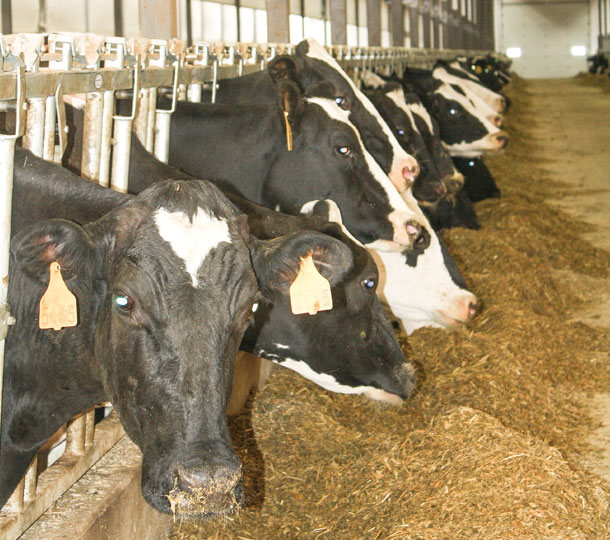Lameness is a highly visible and important animal welfare issue, and nutrition should be part of the focus of managing it, says Mike Hutjens, professor emeritus of animal sciences at the University of Illinois.
Although more research will be needed in the future, there are some nutritional considerations to look at in herds with lameness issues.

Laminitis is inflammation and edema in the hoof, which increases internal pressure and causes pain for the cow. The condition can lead to death of the tissues (necrosis), bleeding and edema. Laminitis predisposes milking cows to sole ulcers, white-line disease and toe necrosis, so it has a considerable economic impact on the dairy industry, he says.
Hutjens says the cost of lameness has been estimated to be $126 per cow (treatment, lost milk, reproduction delays or culling).
Animals in pain walk less, and Hutjens says the stagnation of the blood flow from inactivity can cause further damage to the laminae, the thin layer of tissue within the wall of the hoof.
Acidosis is beginning to be the primary predisposing factor because it disrupts the blood supply to the foot. Problems can start as young as 6 months old and may become more severe as the animal ages, Hutjens says.
Acidosis is caused by the consumption of an excess of rapidly fermentable carbohydrates. Rumen pH becomes too low, the rumen wall cannot absorb all the volatile fatty acids, lactic acid bacteria proliferates, substances are released in the blood that affect the diameter of blood vessels, and the blood vessels in the laminae are damaged.
Subacute rumen acidosis can start at a rumen pH below 5.8 and depends on the length of time below this value, he says.
Rumen acidosis can be controlled by the following practices:
- Reduce starch levels (less than 30 percent).
- Evaluate the rate of starch fermentation in the rumen (particle size, moisture level of the starch such as high-moisture corn or corn silage stored for over four months).
- Monitor the level of effective fiber leading to over 550 minutes of cud chewing.
- Observe feeding behavior (slug feeding of concentrate, sorting and overcrowding the feedbunk).
- Add feed additives such as buffers, yeast products and probiotics.
Copper may be lacking in dairy diets, he notes. Copper is necessary for the synthesis and maintenance for elastic tissues such as tendons. Copper assists in producing thiol oxidase, which increases hoof hardness and helps to increase the cow’s immunity.
Cows should be receiving 10 to 15 parts per million of copper daily, with one-third of that coming from organic sources such as a proteinate, amino acid or hydroxyl form.
Dairy cows should be consuming 40 to 60 parts per million of zinc daily. Zinc contributes to wound healing, keratin synthesis and epithelium maintenance. “All of which adds up to improved hoof health,” Hutjens says.
He cites a study where 3,000 cows receiving recommended amounts of organic zinc had a 34 percent reduction of white-line disease, 11 percent reduction of sole ulcers and a 33 percent reduction in digital dermatitis.
Hutjens says other mineral considerations include manganese for bone density and joint structure (40 to 60 parts per million), sulfur for amino acid synthesis and vitamins (0.25 to 0.28 percent of the ration dry matter) and calcium and phosphorus for bone formation and skeletal soundness.
Biotin can improve hooves by reducing heel warts, claw lesions, white-line separations, sand cracks and sole ulcers, and it can increase milk yield. He noted 10 to 20 milligrams per cow per day for six months to a year may be needed before observing improvement in hoof health.
Hutjens says the cost of 8 to 10 cents a day per cow will reap up to four times the return based on milk production response that occurs within weeks. (This does not include the added value of hoof health improvement.)
Hutjens cited studies that showed biotin had a “significant improvement” in white-line lesions.
Younger animals can be fed 3.8 parts per million organic iodine (ethylene diamine dihydroiodide) as part of the total ration dry matter. Heifers fed iodine for at least 49 days were less likely to have digital dermatitis and less likely to have repeat cases.
According to FDA guidelines, lactating cows should not be fed these higher levels of iodine because it will increase iodine levels in milk above the allowed threshold.
Preventing lameness often comes down to detecting signs early and dealing with the issue through proper nutrition, comfortable facilities, routine hoof care and prompt treatment. ![]()
PHOTO: What happens at the feedbunk affects cows’ feet. Reducing starch levels and monitoring the rate of starch fermentation are a few recommendations for preventing acidosis and lameness. Photo by Peggy Coffeen.
Kelli Boylen is a freelance writer based in Waterville, Iowa.





